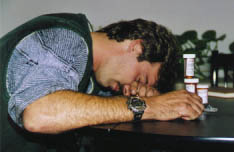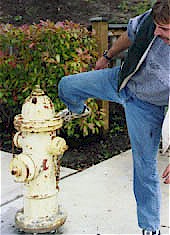"If both men and
women would perform this posture twice a day, the world would undergo a great
change."
-Dr. Margaret Flushing |


|
Dog Mirroring Therapy Cures
Chronic Depression. |
 |
 CN. THE BATEMAN CLINIC. VANCOUVER, BRITISH COLUMBIA. The pioneering work of two
Bateman Clinic Doctors, Margaret Flushing and Hudo Mekowski, has given the world of the
chronically depressed a new leash on life. CN. THE BATEMAN CLINIC. VANCOUVER, BRITISH COLUMBIA. The pioneering work of two
Bateman Clinic Doctors, Margaret Flushing and Hudo Mekowski, has given the world of the
chronically depressed a new leash on life.
Test subject, Jack Murphy, in the pit
of chronic depression. |
Jack Murphy (pictured above) was one of many chronically depressed patients seeking help
at the Bateman Clinic. He had been under psychiatric care since the age of 13. His 20
years of depression kept him immobilized and unable to hold down a job. Although certain
drugs had made improvements in Jack's behavior, he would always fall back. Suicide seemed
the only hope to end his battle with depression.Dr. Margaret Flushing and Dr. Hudo
Mekowski had joked with each other about a form of 'Dog Therapy,' since both doctors were
dog lovers and had always made them a big part of their lives. They both knew that dogs
were born optimists. They also realized that how one acts correlates with how one feels.
Dogs 'acted' happy, and because of their actions, they were just that: happy.
Both Flushing and Mekowski had been using a form of therapy based on a model by Alfred
Adler, which loosely stated is: you must become best friends with your patient to enact a
cure. Of course, like most theorys of therapy it sounded good and worked in some cases,
but it failed miserably with the chronically depressed. Flushing and Mekowski decided that
being a depressed patient's best friend wasn't enough. They decided to go one step
further. Instead of being their patient's best friend, they would turn the patient into
man's best friend-the dog. Their controversial therapy became know as 'Dog Mirroring.' |

Jack Murphy became the first patient of Dog Mirroring (or DT's, short for Dog Therapy as
it became known to the other Doctors at the Bateman Clinic). Here the patient is shown in
a basic 'begging posture.' According to Dr. Flushing, this posture allows the patient to
focus his mind while experiencing the happiness of awaiting a treat. A look of 'please' in
the eyes while holding this posture teaches basic humility. |

This picture shows Jack Murphy in the 'sniffing the fire hydrant posture.' Dr. Mekowski
explains, "the SFH posture allows the patient to re-experience their environment,
something that most chronically depressed have been estranged from. It also builds
self-esteem by letting the patient know that even the most seemingly trivial act of
urinating is something that one can enjoy; both the foreplay and the act itself."
Both Flushing and Mekowski recommend this posture to anyone who has lost the childlike
innocence of 'going to the potty.' |

Here we show the patient bringing the 'sniffing the fire hydrant posture' into its
fruition with the 'peeing on the fire hydrant posture.' Dr. Flushing made note, "this
posture, although somewhat embarrassing to the patient, brings about a sense of serenity
and closure, which most chronically depressed people are desperately needing to
experience. The posture is the same for males and females. I call this posture the Great
Equalizer. If both men and women performed this posture twice a day, the world would
undergo a great change." |

|
| Here we show the patient, Jack Murphy, cured of his
depression after only one month of intensive Dog Mirroring Therapy. Jack is shown here
performing the 'catch the stick posture.' "The only side effect of Mirroring Therapy
so far," reported Dr. Mekowski, "is the rolling of the eyes into the back of the
head syndrome. The only other problem we have experienced is the patient's
compulsion to chase cars and howl at night, but we are confident that we can control these
compulsions with the correct dosage of LSD." Back to CONJECTURE NEWS |
copyright 2009 by CN |